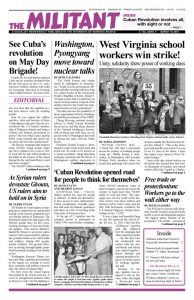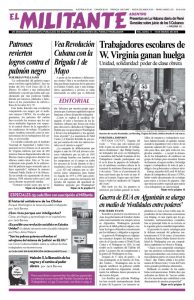The Bashar al-Assad regime is stepping up its murderous air and ground assault on the heavily populated eastern Ghouta suburb of Damascus. The dictatorial regime has laid siege to the 400,000 people there for five years, creating shortages of food and medical supplies. This newest offensive, backed by Moscow’s air power and in concert with Iranian-backed militias, has pounded urban areas with bombs and artillery, killing 800 people, mainly civilians. The ground offensive is moving through lightly populated farmlands seeking to cut Ghouta in two.
Washington, Moscow, Tehran, Ankara and other capitalist governments in the region are seeking to assert their economic and military interests since the defeat of Islamic State.
For four years the Assad regime lost ground in the Syrian civil war. It owes its strengthened position today to Moscow’s entry into the fighting in 2015 and the central role of the ground forces of Hezbollah and other Tehran-backed militias.
At the same time, the U.S. rulers and allied Kurdish-led Syrian Democratic Forces control 25 percent of the country, including both the Kurdish cantons and many of the regime’s oil fields near the Euphrates River.
Across the region the impact of the Syrian war falls hardest on working people. The war began after a popular rebellion against Assad broke out in 2011 and the regime responded with bloody repression. Over half the country’s population has been forced to abandon their homes during the war. More than 5 million Syrians have fled to Turkey, Jordan and Lebanon. Along with other working people there they confront rising competition for jobs, housing, education for their children and health care.
Two years after Jordan started issuing work permits to Syrian refugees, some 90,000 have received them out of an estimated 1.3 million. The rest seek work without “permits” or are dependent on niggardly government aid.
Of Lebanon’s population of 6 million, some 1.5 million are Syrians refugees. In the rural Bekaa Valley, where many Syrians have settled, bosses have used the increased competition among workers to drive down wages by up to 60 percent.
Turkish President Recep Tayyip Erdogan says one key aim of his government’s invasion of the Kurdish province of Afrin in Syria is to resettle Syrians that fled to Turkey, even though most of them are not from that part of Syria. The central goal of Turkey’s rulers is to deal a blow to the Kurdish people’s fight for national rights in Syria, and to intimidate Kurds in Turkey from rising up.
Ankara intensified its airstrikes after the Assad regime organized pro-government militias to enter the province and aid the Kurds. Assad hopes to reassert Syrian government control over Afrin.
Israeli Prime Minister Benjamin Netanyahu flew to Washington and met with President Donald Trump March 5 to discuss further steps to counter Tehran’s growing influence. At the center of their discussions were Washington’s efforts to toughen the 2015 deal struck with the Iranian rulers to slow down their nuclear weapons program. They also discussed how to prevent Tehran from making its foothold in Syria permanent, from where weapons are transported to its Hezbollah ally in Lebanon.
The rulers in Tel Aviv intend to use whatever force is necessary to keep Tehran and Hezbollah from threatening Israel.
Saudi rulers seek backing for Yemen war
Saudi Arabian Crown Prince Mohammed bin Salman began a trip to consult with the capitalist governments in Egypt, the U.K. and U.S. March 4. One of his objectives is to win more support for the war the Saudi rulers are waging in Yemen. A Saudi-led coalition is carrying out airstrikes and enforcing a blockade against Tehran-backed Houthis, who seized control of Sana’a, Yemen’s capital, in 2015. Some 10,000 people, mainly civilians, have been killed, 2 million displaced and millions face cholera and starvation.
The Saud monarchy, with Washington’s backing, wants to deal blows to Iran’s capitalist rulers, its main rival, who have extended their counterrevolutionary sway across the Mideast in the course of the wars in Iraq, Syria and Yemen. Riyadh’s desire to challenge Tehran is a key reason behind the campaign for capitalist “modernization.” Advanced by Prince Mohammed, it seeks to overcome the kingdom’s social backwardness, weaken the grip of stifling Wahabi Sunni religious strictures and expand the economy to reduce dependence on oil revenues.
One unintended consequence of the Saudi rulers’ steps to draw more women into modern life and the workforce will be to strengthen the working class. When the regime advertised 140 jobs for women at airports and border crossings, 107,000 applied. The government is taking steps to weaken the system of male guardianship, where husbands or male relatives control women’s ability to work, travel or start their own business.
Prior to his trip, Prince Mohammed, who is also the country’s defense minister, sacked the military’s joint chiefs of staff, replacing the central officer corps with forces loyal to him.

